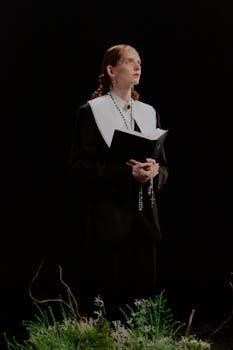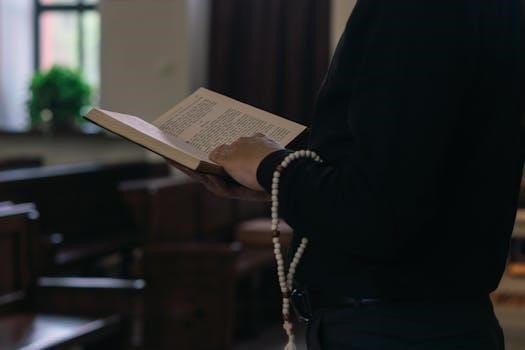
-
By:
- otis
- No comment
my complete rosary prayer book pdf
Understanding the Rosary Prayer Book

Rosary prayer books are essential guides for those seeking to deepen their devotion through the Rosary. These books usually contain the key prayers, such as the Apostles’ Creed, Our Father, Hail Mary, and Glory Be. They also outline the Mysteries, providing a pathway for meditation on the life of Jesus.
Rosary prayer books serve as invaluable companions for individuals engaging in the Rosary devotion. These books typically compile the fundamental prayers recited during the Rosary, ensuring that users can easily follow the traditional sequence. Beyond simply listing prayers, they often include explanations of the Rosary’s structure and its spiritual significance. A complete rosary prayer book may provide insights into the Mysteries of the Rosary, helping users to meditate more deeply on each event in the life of Jesus and Mary. Some books include additional prayers and devotions, expanding the scope of one’s prayer life. Furthermore, various versions might exist, catering to different preferences or spiritual traditions within the Catholic Church. These prayer books may come in printed or digital formats, such as a PDF, making them widely accessible. They help to maintain consistency and order during prayer, ensuring that the Rosary is prayed properly. The books often act as a bridge, connecting individuals to the rich heritage of Rosary prayer. They are a good tool, offering a guided path to engage with this cherished devotion.
Key Prayers Included in Rosary Books
Rosary prayer books are typically structured around a core set of prayers that form the basis of the Rosary devotion. These key prayers are essential for anyone wishing to pray the Rosary correctly and meaningfully. Foremost among these is the Apostles’ Creed, a statement of Christian faith recited at the beginning of the Rosary. The Our Father, taught by Jesus himself, is another central prayer repeated throughout the Rosary. The Hail Mary, a prayer honoring the Virgin Mary, is recited multiple times in each decade. The Glory Be, a doxology praising the Holy Trinity, is prayed after each decade of Hail Marys. Additionally, many Rosary books include the Fatima Prayer, which is often recited after the Glory Be. These prayers are provided in full within the prayer book, ensuring that the user has easy access to them. The order of prayers is also clearly outlined, making it easier to follow along during the Rosary. These books may also include explanations of each prayer’s significance and historical context, enhancing the prayerful experience. The inclusion of these key prayers makes Rosary books practical and user-friendly, allowing individuals to focus on the spiritual dimension of their prayer.

Prayers and Mysteries
The Rosary combines vocal prayer with meditation on the Mysteries of Christ’s life. Key prayers such as the Apostles’ Creed, Our Father, Hail Mary, and Glory Be are fundamental. These, alongside the Mysteries, form the structure of the Rosary devotion.
The Apostles’ Creed in the Rosary
The Apostles’ Creed serves as a foundational statement of Christian belief, and it holds a significant place within the Rosary prayer. It is traditionally recited at the very beginning of the Rosary, after making the Sign of the Cross. This practice establishes a solid theological grounding for the prayers that follow, reaffirming faith in God the Father, Jesus Christ His Son, and the Holy Spirit. By reciting the creed, we declare our belief in the core tenets of Christianity, connecting our devotion to the ancient traditions of the Church. The act of stating these fundamental beliefs sets the tone for prayer, and it helps to ground our meditation on the life of Christ within the broader context of salvation history. The Apostles’ Creed is not just a rote recitation; it is a powerful affirmation of the Christian faith that prepares the heart and mind for deeper reflection on the mysteries of the Rosary. It serves as a reminder of the truths we believe and the foundation upon which our faith is built. It is a bridge connecting us to the early church and its teachings.
Reciting the Our Father

The Our Father, also known as the Lord’s Prayer, is a central prayer in Christianity and a vital component of the Rosary. It is recited once at the beginning of each decade of the Rosary, following the Apostles’ Creed. This prayer, taught by Jesus himself, serves as a model for how we should approach God in prayer. It encompasses praise, petition, and submission to God’s will, making it a comprehensive prayer for all times and circumstances. Within the Rosary, the Our Father acts as a bridge between the different mysteries, providing a moment to refocus on God’s presence and acknowledge His sovereignty. The recitation of the Our Father is not a mere repetition of words; rather, it is an opportunity to enter into deeper communion with God, reflecting on the meaning behind each phrase. The prayer calls us to seek God’s kingdom, ask for our daily needs, forgive others as we have been forgiven, and seek protection from evil. In this way, the Our Father forms the spiritual backbone of each decade of the Rosary, adding meaning and purpose to our meditation.
The Hail Mary Prayer
The Hail Mary is the foundational prayer of the Rosary, repeated ten times within each decade. This prayer combines scriptural verses and a petition for Mary’s intercession. The first part, “Hail Mary, full of grace, the Lord is with thee; blessed art thou among women, and blessed is the fruit of thy womb, Jesus,” is derived from the Angel Gabriel’s greeting to Mary at the Annunciation and Elizabeth’s salutation during the Visitation. This section acknowledges Mary’s unique role in salvation history as the Mother of God. The second part, “Holy Mary, Mother of God, pray for us sinners, now and at the hour of our death. Amen,” is a request for Mary’s ongoing intercession on our behalf. This part recognizes her powerful connection to her Son and her ability to assist us throughout our lives and at the hour of our death. The Hail Mary, therefore, is a prayer of praise and petition, uniting us with Mary and through her, leading us closer to Jesus. The repetition of this prayer in the Rosary encourages meditation on the mysteries of Christ’s life through the eyes of His mother, and this form of prayer fosters both devotion and contemplation.
Praying the Glory Be
The Glory Be, also known as the Doxology, is a short but powerful prayer that is recited after each decade of the Rosary, following the ten Hail Marys. This prayer offers praise and adoration to the Holy Trinity⁚ the Father, the Son, and the Holy Spirit. The text of the prayer is simple, stating⁚ “Glory be to the Father, and to the Son, and to the Holy Spirit; as it was in the beginning, is now, and ever shall be, world without end. Amen.” It is a profound expression of faith in the triune God and acknowledges His eternal nature and glory. The Glory Be serves as a reminder that all our prayers and devotions are ultimately directed towards God. Through this prayer, we recognize God’s majesty, His timeless presence, and His boundless love. The act of reciting the Glory Be provides a moment of reflection and a return to the central focus of Christian belief after each set of Hail Marys. It also connects us to the tradition of the Church, as this ancient prayer has been used for centuries, serving as a powerful way to conclude each decade of the Rosary.
Mysteries of the Rosary
The Mysteries of the Rosary are meditations on specific events in the lives of Jesus and Mary, divided into four sets⁚ the Joyful, Sorrowful, Glorious, and Luminous Mysteries. Each set contains five mysteries, providing a framework for contemplation during the recitation of the Rosary. The Joyful Mysteries focus on the early life of Jesus, including the Annunciation, the Visitation, the Nativity, the Presentation in the Temple, and the Finding of Jesus in the Temple. The Sorrowful Mysteries center on the suffering and death of Jesus, including the Agony in the Garden, the Scourging at the Pillar, the Crowning with Thorns, the Carrying of the Cross, and the Crucifixion. The Glorious Mysteries celebrate the resurrection and ascension of Jesus, and the role of Mary in salvation, including the Resurrection, the Ascension, the Descent of the Holy Spirit, the Assumption of Mary, and the Coronation of Mary. The Luminous Mysteries, added by Pope John Paul II, emphasize Jesus’ public ministry, including the Baptism of Jesus, the Wedding at Cana, the Proclamation of the Kingdom, the Transfiguration, and the Institution of the Eucharist. Each mystery offers a unique opportunity for prayer and contemplation.

Rosary Practices and Devotions
Rosary practices involve a structured approach to prayer, often following a schedule that assigns specific mysteries to each day. Many choose to offer decades in honor of a particular mystery. The Rosary is known for its promises to those who faithfully pray it.
Praying the Rosary Schedule
Establishing a consistent schedule for praying the Rosary can greatly enhance your spiritual life. A common practice is to dedicate specific days to certain sets of mysteries. Traditionally, the Joyful Mysteries are recited on Mondays and Saturdays, focusing on the early life of Jesus and Mary. Tuesdays and Fridays are often reserved for the Sorrowful Mysteries, which contemplate the Passion and death of Christ. The Glorious Mysteries, reflecting the Resurrection and heavenly glory, are typically prayed on Wednesdays and Sundays. This structured approach helps maintain focus and provides a rhythm to your prayer life. Many find that adhering to this schedule allows for a deeper contemplation of the mysteries, fostering a more profound connection with God. Some individuals adjust this traditional schedule to fit their personal circumstances, but the key is establishing a regular routine that allows for consistent prayer. Utilizing a prayer book can help you stay on track, providing reminders and guidance throughout your Rosary practice. The routine helps to engage the mind and heart more fully, making each prayer more intentional and meaningful.
Offering Decades in Honor of Mysteries
When praying the Rosary, a powerful practice is to consciously offer each decade in honor of a specific mystery. This involves focusing your intention on the particular event in the lives of Jesus and Mary that the mystery represents. For example, when praying the first decade of the Joyful Mysteries, you might offer it in honor of the Annunciation, meditating on Mary’s acceptance of God’s will. This practice elevates the Rosary from mere recitation to a profound contemplation of sacred events. Each decade becomes an opportunity to enter more deeply into the mystery, allowing it to shape your thoughts and prayers. By offering the decades intentionally, you actively participate in the story of salvation, drawing closer to Christ through Mary. The mysteries are not just historical events; they are living realities that can transform your heart and mind. This approach not only honors the mysteries but also enhances the efficacy of the prayer, turning each decade into a meaningful spiritual exercise. Using a prayer book can help remind you of the particular mystery to contemplate, enriching your prayer experience.
The Promises of the Rosary
The Rosary, a prayer deeply cherished by many, is associated with numerous promises said to be given by the Blessed Virgin Mary to those who faithfully pray it. These promises, often found in Rosary prayer books, offer spiritual comfort and encouragement to devotees. One significant promise is that those who serve Mary by reciting the Rosary will receive signal graces. These graces are not merely worldly blessings but also spiritual gifts that can lead to deeper faith and a closer relationship with God. Another promise states that the Rosary is a powerful tool for overcoming sin and temptation. It’s believed that consistent prayer of the Rosary can help one break free from bad habits and cultivate virtue. Additionally, the Rosary is said to provide protection from harm and guidance during times of difficulty. Many believers find solace in the promise that Our Lady intercedes for those who pray the Rosary, bringing their petitions before God. The Rosary is also seen as a means of obtaining peace, both in the world and in one’s own heart, and that those who pray the Rosary will find true happiness.